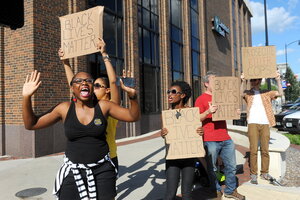Ferguson ends state of emergency as week of protests comes to a close
Demonstrations in Ferguson have remained peaceful since county official issued the state of emergency on Monday in response to an outbreak of violence during a late-night protest on Sunday.

Tamar Hodges (l.) chants 'Black Lives Matter' with fellow protestors from left, Veronica Newton, Taj Sconyers, Wayne Brekhus and Jack Buthod as they hold signs at Broadway and Eighth Street to counter protest a group across the street who were supporting former Ferguson police officer Darren Wilson and Columbia police, Wednesday.
Don Shrubshell/The Columbia Daily Tribune/AP
After three nights of calm in Ferguson, Mo., St. Louis County officials lifted the state of emergency imposed on the town after shootings rocked the protests staged to mark the anniversary of Michael Brown’s death.
A year after Mr. Brown was fatally shot by white Ferguson police officer Darren Wilson, protesters took to the streets where Brown died. Violence erupted on Sunday night and police shot and critically wounded another black 18-year-old. On Monday, city officials declared a preemptive state of emergency in the city that lasted throughout the week.
Perhaps the most surprising addition to the Ferguson demonstrations was a group of armed white vigilantes who called themselves the ‘Oath Keepers,’ The Christian Science Monitor reported Tuesday.
Who exactly are these mysterious Oath Keepers? According to the group’s website, it’s a non-partisan association of current and former military, police, and first responders who pledge to fulfill the oath all military and police take to “defend the Constitution against all enemies, foreign and domestic.”
St. Louis County Police Chief Jon Belmar described their presence as "both unnecessary and inflammatory."
But despite the incidents of violence earlier in the week and the unwelcome additions, many observers say that the nation has come a long way since the death that fueled the Black Lives Matter movement.
“The protest movement that erupted in outrage on West Florissant Avenue last August, in the year since Brown's death has grown into a national movement that Professor Hansford [a professor at the St. Louis University School of Law] and others have called the next generation of the civil rights movement,” the Monitor reported Wednesday.
“The police, meanwhile, who have a new chief and a new mandate for reform after a blistering Justice Department report came out in March, won praise from at least some observers for acting with restraint and employing de-escalation techniques during anniversary events,” the Monitor's Henry Gass reported.
Moreover, some have pointed to increased unity between black and white residents in Ferguson.
“At the time [of Wilson’s death], views of the Aug. 9, 2014, killing of Mr. Brown, a black teen, by white Ferguson police officer Darren Wilson sharply divided white and black Americans. But new polls show a stirring of thought on the issue of race, suggesting that the efforts of the past year – including the rise of the Black Lives Matter movement – have had an effect,” the Monitor reported in early August.
“Some 53 percent of white Americans surveyed by the Pew Research Center said that the country needs to continue changing to give blacks equal rights. Last year, the figure was 39 percent.”

